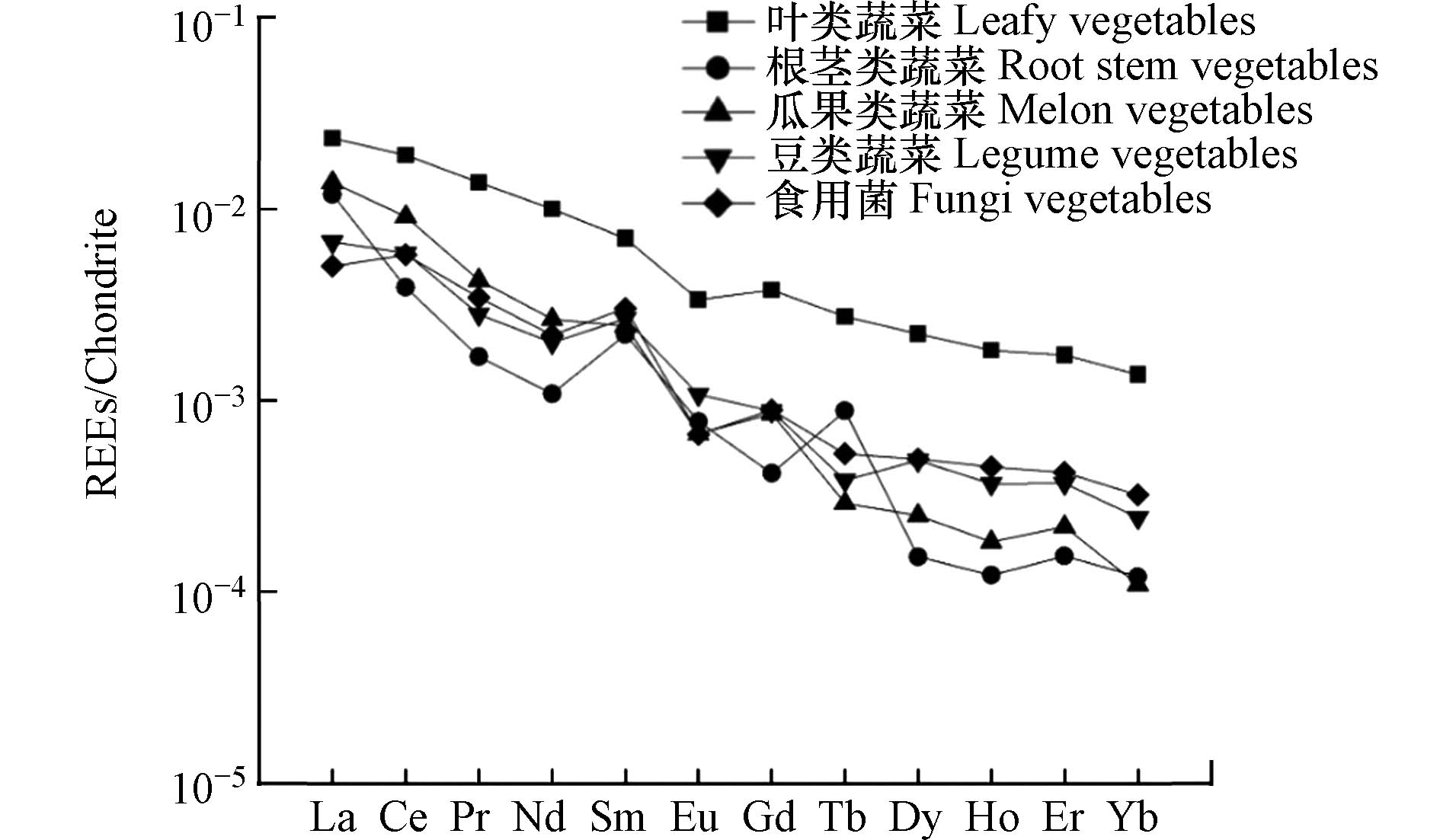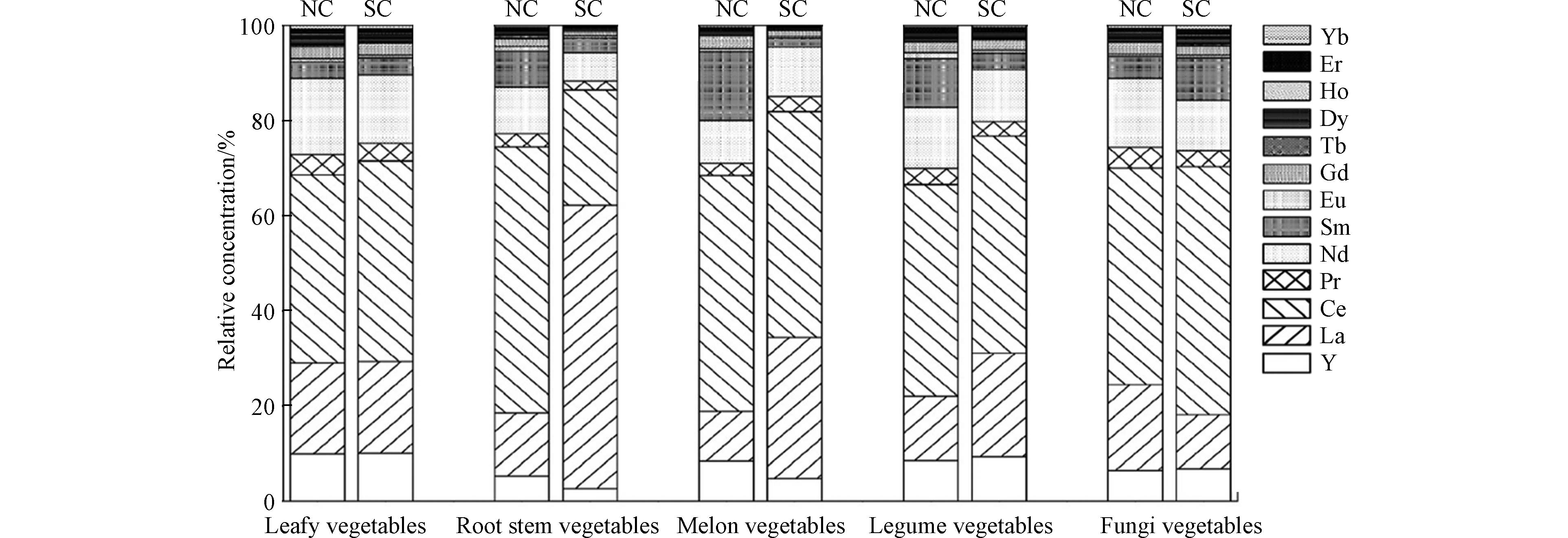-
稀土元素 (REEs) 由于其特殊的物理和化学性质,过去的几十年中在地球化学、农业、冶金、电子、激光、核工业和超导体领域中的广泛使用[1-4]. 近年来REEs在越来越多的环境基质中被检测到[5-6]. 据报道,土壤中的REEs含量为 30.8—327.5 ng·kg−1,地表水中的REEs含量为0.17—160.06 μg·L−1 [7-12]. 沉积物和生物体中的REEs分别为 0.0002—9850 mg·kg−1 和 1.95—7.05 mg·kg−1 dw(干重)[13]. 有研究表明,环境基质中的REEs可以通过食物链进入人体[14-15],产生潜在的健康风险. 中国拥有全球最丰富的 REEs 资源,占全球97%的 REEs 供应量[16-17],这可能会导致中国与其他国家相比具有更高的 REEs 污染水平和潜在风险. 因此,研究中国稀土元素膳食暴露特征具有重要意义和代表性.
REEs的广泛使用不仅会污染环境,而且会在生物体积累. 已有毒理学研究表明REEs主要的靶器官包括脑、肝、肾、甲状腺和甲状旁腺[8]. 据报道,脑中高浓度的 Gd会引起神经毒性[18],其他REEs还会降低大脑的智力水平,最终导致记忆力减退[19]. 此外,REEs 还可以在人体骨骼中积累并最终导致基因毒性[20]. REEs还可以穿过胎盘和血脑屏障,进而在胎儿体内蓄积,从而导致出生缺陷[21]. 已有研究表明在有神经管缺陷的新生儿中发现的 Ce 和 La 的累积水平更高[22]. 在中国矿区,居民血液中REEs含量和当地土壤中 REEs浓度显著相关[23],表明在受污染的土壤中生长的植物能够积累REEs,REEs进一步通过食物网进入人体.
目前,国内对稀土元素的研究大多集中在矿区土壤、饮用水和农作物中[24-26]. 据报道,中国最大的重稀土生产区江西赣州,其尾矿土壤的稀土元素水平高达 3179 mg·kg−1 [27],溪水高达 4.46 mg·L−1,农田土壤高达 928 mg·kg−1 [28]. 在中国最大的轻稀土产区包头市,其水体和底泥中的稀土总浓度分别为3.8 mg·L−1和30461 mg·kg−1,远高于华北地区河流的平均值[21]. 此外,矿区蔬菜中的REEs含量为 1.24–2.03 mg·kg−1 [29-31]. 但是与居民健康直接相关的市售食品中稀土元素含量的研究较少. 对中国个别城市食品中稀土元素的调查表明,非矿区蔬菜中的REEs含量为 0.37—1162 μg·kg−1 [32-33].
本研究采集大型农贸市场、超市中具有代表性和适时性的常见蔬菜食品,调查了中国沿海地区日常食用蔬菜中REEs的残留水平和分布特征. 研究成果将有助于了解中国沿海地区居民通过蔬菜摄入REEs的含量,评估人类和生态系统面临的健康风险. 将获得的数据与全国各地其他研究的结果进行比较,也将有助于研究所调查环境中REEs随时间和地点的变化趋势.
-
本实验所用到的高通量微波消解仪(MASTER40)及配套的微机控温加热板(ECH-20)购自上海新仪微波化学科技有限公司,电感耦合等离子体质谱仪(8900 Triple Quadrupole ICP-MS)购自安捷伦科技公司. 本实验用水为Millipore 净水系统 (Millipore D 24 UV)制备的超纯水. 优级纯硝酸(≥65%)和过氧化氢(30%)分别购自CNW(德国)和国药集团化学试剂有限公司. 三文鱼认证标准物质(GBW10210)购自坛墨质检. 此外,含有16种稀土元素的混合标准溶液购自安捷伦科技有限公司(Agilent ICP-MS-CAL-1-1).
-
采样点位置如图1所示. 采样点的详细信息参考先前的研究[34]. 2018年4—9月,在我国沿海地区主要城市(大连、营口、秦皇岛、天津、青岛、苏州、舟山、上海、福州、泉州和广州)的超市和零售店,根据随机抽样原则采集本地出产且居民当季常食用的蔬菜类共105份,其中北方沿海地区47份,南方沿海地区58份,不同类别的蔬菜样本量如表1 所示. 采集的蔬菜覆盖居民经常食用的叶类蔬菜、根茎类蔬菜、瓜果类蔬菜、豆类蔬菜以及食用菌5大类. 采集的样品用聚乙烯真空袋包装,并立即用低温冰盒运输至实验室,并保存在–20 ℃冰箱直至进一步分析.
-
采集的蔬菜样品丢弃不可食用部分后,先用自来水冲洗以去除表面黏附的泥土,再用超纯水冲洗. 然后按食品类别将同一采样区域的每个样品中可食用部分混合制备同类蔬菜的混合样品,所有混合样品匀浆后冷冻干燥,共获得10个混合蔬菜样品.
蔬菜样品采用微波消解法进行前处理,步骤如下:取冻干后的蔬菜样品约 0.3 g(精度为 0.001 g)于聚四氟乙烯消解罐中. 先加入 8 mL HNO3进行预消解,预消解完成后在缓慢加入 2 mL H2O2,加盖密封后置于微波消解仪中进行消解. 微波消解程序如下:先在 10 min内将温度加热到 150 ℃,然后升至 180 ℃并保持 20 min. 消解完成后,将消解罐直接移到加热板上,在100 ℃下赶酸. 赶酸结束后,将消解液转移到容量瓶中,用超纯水洗涤消解罐3—4次,洗涤液一并移入容量瓶中,用超纯水稀释至 25 mL. 最后,用 0.45 µm 尼龙膜过滤,4 ℃保存用于仪器分析. 在每批消解样品的同时跟平行对照和空白对照. 稀土元素采用电感耦合等离子体质谱仪测定,测定结果以干重为单位,数据处理时除以相应的干重占比以转化为鲜重时的浓度.
-
消解罐在实验前一天于浓度为22%的硝酸中浸泡一夜,再用超纯水冲洗晾干后用于样品消解,实验所用到的玻璃和聚四氟器皿均采用该方法清洗. 此外,通过测定平行样品、空白样品以及菠菜标准物质(GBW10015a)进行实验内部质量控制. 待测元素的标准曲线范围为0.01—10 μg·L−1,标准曲线中各元素的相关系数均大于0.9998. 本次实验菠菜标准物质中稀土元素的回收率为85.4% —108.2%. 样品空白连续测定6次,计算其3倍标准偏差得到方法检出限(LOD). Y、La、Ce、Pr、Nd、Sm、Eu、Gd、Tb、Dy、Ho、Er和Yb的LOD分别为0.0019、0.0007、0.0016、0.0020、0.0017、0.0010、0.0015、0.0015、0.0010、0.0015、0.0009、0.0012、0.0019 μg·kg−1. 当检测元素的浓度低于 LOD(精确到±0.001 μg·kg−1)时,使用 LOD 的一半进行计算. 当某元素在所有样品中的检出率小于50%时,该元素视为未检出,不参与计算.
-
蔬菜中的REEs主要经饮食摄入,本研究采用美国环保局推荐的健康风险评估方法US EPA(1989) [35]对蔬菜中REEs经饮食摄入对人体可能造成的健康风险进行评价. 并根据公式(1)计算其每日允许摄入量(EDI).
式中,EDI为稀土元素日摄入量,单位为μg·(kg·d)−1;Cn蔬菜样品中可食部分中稀土元素的含量,单位为μg·kg−1 fw;CR为蔬菜日消耗量,单位kg·d−1,根据国家统计局2021年公布的数据,对于北方沿海地区居民,CR取304 g·d−1,对于南方沿海地区居民,CR取279 g·d−1;BW为成年人平均体重,本研究中BW取标准体重60 kg.
-
采用球粒陨石模型对不同种类蔬菜样品中REEs的浓度进行标准化,以获得我国东部沿海地区蔬菜样品中稀土元素的分馏模式,如图2所示. 从总体上看,5种蔬菜样品中REEs的分馏模式一致(均向右倾斜),表明不同蔬菜样品中REEs具有相似的分馏特征. 其中,LREEs(La to Eu)所在的曲线部分较陡,HREEs(Gd to Yb)所在的曲线部分较为平缓,表明LREEs和HREEs之间存在明显的分异. 我国沿海地区蔬菜样品中LREEs和HREEs的分布特征见表2. 具体来看,5种蔬菜样品中LREEs和HREEs含量的平均值分别为14.4 μg·kg−1 fw和2.2 μg·kg−1 fw,表明蔬菜样品中LREEs占比极大. 此外,沿海地区的LREE/HREE值在根茎类蔬菜和瓜果类蔬菜中具有显著不同,南方沿海地区的LREE/HREE值约为北方沿海地区的2倍.
据王祖伟等[36]的研究报道,我国土壤中LREE/HREE值大于6,表明土壤对LREEs的富集能力更强. 蔬菜样品中LREE/HREE的平均值为8.43,并且具有与土壤中REEs一致的分馏规律,表明蔬菜样品中REEs累积水平很可能受生长地土壤环境的影响. 我国沿海地区的LREE/HREE值在根茎类蔬菜和瓜果类蔬菜中具有显著不同,可能是由于我国南方和北方耕作制度与土壤性质有明显差异所导致的,南北方气候的差异导致北方沿海地区种植的作物大多为一年一熟,而南方沿海地区种植的作物大多为一年二至三熟. 长期耕种,导致土壤酸化,使得土壤中大量REEs由不可利用态转化为可利用态,进而被农作物吸收,可能是造成该现象的主要原因.
-
本研究对蔬菜样品中15种稀土元素进行了检测,其中Tm和Lu在所测蔬菜水果中未检出,因此在实验数据中未列出. 不同种类蔬菜中稀土元素的含量如图3所示,北方沿海地区(ΣREE 为16.53 μg·kg−1 fw)与南方沿海地区(ΣREE 为16.73 μg·kg−1 fw)5种蔬菜样品中稀土元素残留水平相当. 其中,北方沿海地区叶类蔬菜REEs水平最高(ΣREE为55.16 μg·kg−1 fw),南方沿海瓜类蔬菜REEs最高(ΣREE为28.28 μg·kg−1 fw). 北方沿海地区出产蔬菜中稀土元素含量由高至低依次为叶类蔬菜>食用菌>根茎类蔬菜>豆类蔬菜>瓜果类蔬菜,南方沿海地区出产蔬菜中稀土元素含量由高至低依次为瓜果类蔬菜>叶类蔬菜>豆类蔬菜>根茎类蔬菜>食用菌. 此外,从表2所列的数据可以计算出2018年我国沿海地区出产蔬菜中稀土元素含量范围为2.72—55.16 μg·kg−1 fw,平均含量为 16.63 μg·kg−1 fw,整体处于较低水平. 其中叶菜类的稀土元素平均含量最高,为38.43 μg·kg−1 fw,其次是瓜果类蔬菜(15.50 μg·kg−1 fw)、豆类蔬菜(10.54 μg·kg−1 fw)和食用菌(9.86 μg·kg−1 fw),含量最低的是根茎类蔬菜(8.82 μg·kg−1 fw).
与2014第四次中国总膳食研究[37]的结果相比(蔬菜中稀土元素平均值为45.8 μg·kg−1 fw),表明REEs在蔬菜样品中的残留水平呈减少趋势. 与近年来已有研究报道的蔬菜中稀土元素水平相比,本研究所测的稀土元素水平低于福州市[32](141 μg·kg−1 fw)、包头市[29](390 μg·kg−1 fw)和自贡市(37 μg·kg−1 fw)[33]当地出产蔬菜中稀土元素的水平,也低于我国在2009-2010年开展的四省两市蔬菜样品中稀土含量水平(稀土元素均值为280 μg·kg−1 fw)[38],表明我国沿海地区食品中稀土含量水平相对比较低. 此外,将本次测得稀土元素水平与稀土矿区附近相比较,发现本研究所测的稀土元素水平也明显低于鄂西北地区[30](100 μg·kg−1 fw、赣南地区[31](843 μg·kg−1 fw)、山东地区[39](1555 μg·kg−1 fw)和江西[40]等地(3007 μg·kg−1 fw). 矿区土壤中稀土元素含量较高可能是导致该区蔬菜中稀土元素含量高的原因之一.
5种蔬菜对稀土元素的富集程度差异较大,这与蔬菜的生长环境以及自身对环境中稀土元素的吸收转运能力有关. 叶类蔬菜中稀土元素含量最高可能是由于其对稀土元素有与重金属相似的富集作用[39],即通过地下部分从土壤中吸收稀土元素以及地上部分从空气颗粒物中吸附稀土元素. 另外,叶类蔬菜同其他种类蔬菜相比具有更大的比表面积,稀土微肥的大量喷洒使用,使其更容易吸收更多的微肥而使得REEs含量增高. 根茎类蔬菜同其他种类蔬菜相比具有更大的地下面积有利于其从土壤中吸收稀土元素,但其稀土元素的含量最低,说明从土壤中吸收并转运稀土元素并非蔬菜样品中稀土元素的主要来源.
-
蔬菜样品中稀土元素的分布特征如图4所示,尽管沿海地区蔬菜样品中轻稀土元素均占主要比例(北方:86.68%,南方:88.85%),但是北方沿海地区和南方沿海地区不同蔬菜样品中LREEs与HREEs的分布模式差异较大,其中北方沿海地区叶类蔬菜中轻稀土和重稀土含量均具有较高水平,而南方沿海地区轻稀土含量最高的蔬菜是瓜果类蔬菜,重稀土含量最高的蔬菜是叶类蔬菜. 由图5可知,LREEs中含量最高的元素为Ce,占稀土元素构成的51.09%;其次是La,所占比例为24.24%,2者占稀土元素的比例为75.33%. 总体上看,叶类蔬菜和食用菌的稀土元素分布模式南北方差异较小,瓜果类蔬菜和豆类蔬菜的稀土元素分布模式南北方差异也较小,而根茎类蔬菜南北差异较大.
根据魏复盛等[41]对中国土壤中15种稀土元素含量的报道,全国土壤中稀土元素的累积水平ΣREE为179.1 mg·kg−1,其中La的含量为37.4 mg·kg−1,Ce的含量为64.7 mg·kg−1,La和Ce累计占ΣREE的57%以上. 蔬菜样品中稀土元素的分布特征与我国土壤的稀土构成基本一致,表明稀土元素特别是轻稀土更容易通过生物作用而富集在蔬菜等农作物体内,从而造成La和Ce在蔬菜样品中含量远高于其他元素. 从蔬菜样品的稀土元素构成中可以明显看出我国沿海地区LREEs水平显著高于HREEs,可能是由于LREEs是稀土农用的常用元素,使得更多的LREEs通过人为的方式进入到环境中,从而参与到蔬菜对稀土元素的吸收转运过程. 此外,相关性分析结果显示食品中轻、重稀土元素之间均具有正相关性(r=0.93),说明轻、重稀土元素之间具有协同促进的作用. 不同类别蔬菜中金属的累积分布特征存在明显差异,这可能与蔬菜本身特点及生长环境相关.
-
基于蔬菜中稀土元素的残留水平计算了我国沿海地区居民膳食暴露量,如表3所示. 东部沿海地区居民每日通过食用蔬菜摄入稀土的平均含量为0.41 μg·(kg·d)−1,其中北方沿海日均摄入稀土元素的总量为0.42 μg·(kg·d)−1,南方沿海每日平均摄入稀土元素的总量为0.39 μg·(kg·d)−1. 叶类蔬菜对稀土膳食贡献率最大,其次是瓜果类蔬菜,这两者膳食贡献率超过了65.08%,根茎类蔬菜的膳食贡献率很小,仅占10.49%. 北方沿海地区15种稀土元素每日摄入量的范围为0.001—0.178 μg·(kg·d)−1;南方沿海地区5种蔬菜样品的稀土元素日摄入稀土元素的范围为0.001—0.167 μg·(kg·d)−1;其中,Ce的摄入量最大,在北方和南方沿海地区,分别为0.178 μg·(kg·d)−1和0.167 μg·(kg·d)−1;其次是La,分别为0.075 μg·(kg·d)−1和0.109 μg·(kg·d)−1. 其他元素的日均摄入量相对较低. 已有研究表明居民稀土元素摄入70 μg·(kg·d)−1为安全剂量,亚临床损害剂量的临界值为100—110 μg·(kg·d)−1[42]. 我国沿海地区居民每日平均摄入稀土元素的总量为0.41 μg·(kg·d)−1,远低于不安全剂量和亚临床损害剂量. 与周新等[30](7.54 μg·(kg·d)−1)、袁丽娟等[31](10.36 μg·(kg·d)−1)对矿区的研究结果相比,也显著低于矿区稀土元素的EDI值,矿区因开采矿物带来的稀土元素的摄入风险较高.
我国沿海地区五大类蔬菜食品中稀土元素含量水平低于我国其他地区,居民每日通过蔬菜摄入稀土元素的平均值远低于稀土元素摄入的安全剂量,表明正常饮食情况下居民通过食物摄入的稀土量是安全的,但对于食物高消费人群,低耐受的儿童群体等通过饮食的稀土摄入情况还需要进一步的研究. 稀土的暴露途径除了食品以外还有水、环境等,因而我国沿海地区居民的稀土摄入是否安全还需结合水、环境等的污染情况做出综合评价.
-
我国沿海地区5种蔬菜样品中REEs的分馏模式一致,并与土壤中稀土元素的分馏模式相似,表明不同蔬菜样品中REEs具有相似的分馏特征,且很可能受生长地土壤环境的影响. 蔬菜样品中LREEs和HREEs含量的平均值分别为14.44 μg·kg−1 fw和2.19 μg·kg−1 fw,表明LREEs占总稀土元素含量的比重极大. 此外,不同种类的蔬菜对稀土元素的富集程度呈现较大差异,其中叶类蔬菜对稀土元素的富集最为显著,提示人们需加强对叶类蔬菜中稀土元素污染水平进行监测并对稀土微肥的使用进行管控. 基于蔬菜中稀土元素的残留水平计算的我国沿海地区居民膳食暴露量显示,东部沿海地区居民每日通过食用蔬菜摄入稀土的平均含量远低于不安全剂量和亚临床损害剂量,表明中国东部沿海地区日常蔬菜摄入对 REEs 的健康风险是可以接受的.
我国东部沿海地区蔬菜中稀土元素的累积分布特征及健康风险评价
Accumulation characteristics and health risk assessment of rare earth elements in vegetables from the eastern coastal region of China
-
摘要: 为调查我国东部沿海地区蔬菜样品中稀土元素的累积水平和分布特征. 采集了市售叶类、根茎类、瓜果类、豆类及食用菌5类蔬菜样品,采用电感耦合等离子体质谱(ICP-MS)对15种稀土元素(La、Ce、Pr、Nd、Sm、Eu、Gd、Tb、Dy、Ho、Er、Tm、Yb、Lu和Y)进行了分析. 不同蔬菜样品中ΣREE浓度范围为 2.72—55.16 μg·kg−1 fw(鲜重),平均浓度为 16.63 μg·kg−1 fw. 其中,叶类蔬菜的ΣREE含量最高(平均值为38.43 μg·kg−1 fw),而根茎类蔬菜中ΣREE含量最低(8.82 μg·kg−1 fw). 居民通过消费蔬菜样品带来的稀土元素总摄入量为0.41 μg·(kg·d)−1,远低于稀土元素摄入的安全剂量(70 μg·(kg·d)−1),表明正常饮食情况下居民通过蔬菜摄入的稀土量是安全的,但居民的稀土暴露途径还包含其它各种食品摄入,呼吸以及饮水暴露,还受到多种环境因素的影响,我国沿海地区居民的稀土摄入是否安全还需要综合评价.Abstract: Five representative vegetable categories, namely, leafy, root, melons, legumes, and edible fungi vegetables were collected to investigate the residual levels and accumulation characteristics of rare earth elements (REEs) in vegetable samples from the east coast of China, 15 REEs in vegetables were characterized by inductively coupled plasma mass spectrometry (ICP-MS), including La、Ce、Pr、Nd、Sm、Eu、Gd、Tb、Dy、Ho、Er、Tm、Yb、Lu, and Y. The concentrations of REEs in vegetables ranged from 2.72 μg·kg−1 to 55.16 μg·kg−1 fresh weight (fw), with an average of 16.63 μg·kg−1 fw. Leafy vegetables exhibited the highest ΣREE concentration (average 38.43 μg·kg−1 fw), while root vegetables posed the lowest ΣREE concentration (average 8.82 μg·kg−1 fw). The estimated daily intake (EDI) was calculated to evaluate the potential dietary intake risks of REEs. The average EDI of REEs in vegetables was 0.41 μg·kg−1·d−1, which was far lower than the safe dose threshold (70 μg·kg−1·d−1), indicating an acceptable healthy risk of REEs by daily vegetables consumption in the east coast region of China. However, the REEs exposure of residents also include the intake of various other foods, as well as the inhalation and water-drinking exposure, affected by multiple other environment factors. Whether the intake of REEs by residents in coastal areas is safe needs a further comprehensively evaluation.
-
Key words:
- rare earth elements /
- coastal areas /
- vegetables /
- accumulation characteristics /
- dietary exposure.
-

-
表 1 不同类别蔬菜品种及样本量
Table 1. Sample species and sizes of different types of vegetables
样品类别
Sample蔬菜品种及采样量
Vegetables categories and sample volume采集地点
Sampling location叶类蔬菜
Leafy vegetables菠菜Spinacia oleracea L.(3)、上海青Brassica chinensis L.(8)、卷心菜Brassica oleracea L.(4)、生菜Lactuca sativa var. ramosa Hort.(3)、娃娃菜Brassica campestris L.(3)、白菜Brassica pekinensis (Lour. ) Rupr.(1)、红苋菜Amaranthus mangostanus L.(2)、油麦菜Lactuca sativa var. longifoliaf. Lam(2)、芥菜Brassica juncea(1)和菜心Brassica campestris L. ssp. chinensis var.utilis Tsen et Lee(1) 大连、营口、青岛、苏州、上海、舟山、福州、广州 根茎类蔬菜
Root stem vegetables胡萝卜Daucus carota var. sativa Hoffm.(3)、洋葱Allium cepa L.(5)、白萝卜Raphanus sativus(4)、蒜薹Allium sativum L.(2)、山药Dioscoreae Rhizoma(1)、大蒜Allium sativum L.(1)、大葱Allium. fistulosum L.var.gigantum Makino(1)、藕Nelumbo nucifera Gaertn(1)、芹菜Apium graveolens L.(1)和毛茭白Zizania latifolia (Griseb. ) Stapf(1) 大连、营口、天津、青岛、苏州、上海、舟山 瓜果类蔬菜
Melon vegetables西红柿Lycopersicon esculentum(6)、茄子Solanum melongena L.(7)、黄瓜Cucumis sativus L.(6)、丝瓜Luffa aegyptiaca Miller(2)、甜椒Capsicum frutescens L. (syn. C. annuum L. )var. grossum Bailey.(4)、冬瓜Benincasa hispida (Thunb. ) Cogn.(1)、尖椒Capsicum frutescens L.(1)、西葫芦Cucurbita pepo L.(2)、苦瓜Momordica charantia L.(1)、秋葵Abelmoschus esculentus (L. ) Moench(1)和西蓝花Brassica oleracea var. italica Plenck(1) 大连、天津、青岛、苏州、上海、舟山、福州、广州 豆类蔬菜
Legume vegetables芸豆Phaseolus vulgaris(5)、扁豆Lablab purpureus (Linn. ) Sweet(1)、荷兰豆Pisum sativum L.(2)、豇豆Vigna unguiculata (Linn.) Walp.(2)、甜豌豆Lathyrus odoratus(1)、油豆角Phaseolus vulgaris Linn.(1) 营口、秦皇岛、天津、青岛、上海、舟山、泉州 食用菌
Fungi vegetables香菇Lentinula edodes(5)、花菇Lentinus edodes (Berk.)Sing(1)、杏鲍菇Pleurotus eryngii Quel.(3)、鸡腿菇Copyinds comatus (MUII. Fr)Gray(1)、口蘑Tricholoma gambosum(1)、金针菇F. velutipes(1)和白玉菇Hypsizygus marmoreus (Peck) H.E.Bigelow(1) 营口、秦皇岛、青岛、苏州、上海、舟山、泉州 表 2 我国沿海地区蔬菜样品中轻稀土元素和重稀土元素含量
Table 2. Contents of LREEs and HREEs in vegetable samples from coastal areas of China
样品名称
SamplesΣREE/(μg·kg−1 fw) LREEs HREEs LREE/HREE 北方沿海 叶类蔬菜 55.16 45.84 9.32 4.92 根茎类蔬菜 6.50 5.87 0.63 9.35 瓜果类蔬菜 2.72 2.36 0.36 6.53 豆类蔬菜 4.41 3.79 0.63 6.03 食用菌 13.84 12.10 1.74 6.97 南方沿海 叶类蔬菜 21.69 18.15 3.54 5.12 根茎类蔬菜 11.14 10.60 0.54 19.71 瓜果类蔬菜 28.28 26.28 2.00 13.13 豆类蔬菜 16.67 14.25 2.42 5.89 食用菌 5.88 5.11 0.76 6.69 表 3 我国东部沿海地区蔬菜中稀土元素水平以及日摄入值估算(EDI)
Table 3. EDI contribution in vegetable samples from coastal areas of China
元素
Elements浓度范围/(μg·kg−1 fw)
Concentration range平均浓度/(μg·kg−1 fw)
Average concentrationEDI(以体重计)/(μg·(kg·d)−1) 北方沿海 南方沿海 Y
La
Ce
Pr
Nd
Sm
Eu
Gd
Tb
Dy
Ho
Er
Yb0.23—5.44
0.28—10.55
1.35—21.86
0.07—2.34
0.25—8.82
0.35—1.92
0.02—0.37
0.07—1.42
0.00—0.20
0.02—1.10
0.00—0.19
0.02—0.54
0.01—0.421.30±1.6
3.83±3.6
7.10±6.4
0.60±0.7
2.14±2.6
0.67±0.5
0.09±0.1
0.35±0.4
0.05±0.1
0.24±0.3
0.04±0.1
0.12±0.2
0.09±0.10.037
0.075
0.178
0.017
0.062
0.020
0.003
0.010
0.001
0.008
0.001
0.004
0.0030.027
0.109
0.167
0.012
0.043
0.013
0.002
0.007
0.001
0.004
0.001
0.002
0.002∑REE 2.72—55.16 16.63±15.8 0.42 0.39 -
[1] BAKAR I P, ABD-SHUKOR R. Effects of rare-earth elements and alkali metals on the superconductivity of (Tl0.7M0.3)Sr2Ca0.8Cr0.2Cu2O7 with M = Gd, Er, La, Li, Na, K, and Rb [J]. Journal of Alloys and Compounds, 2019, 772: 745-750. doi: 10.1016/j.jallcom.2018.09.193 [2] DANG D H, WANG W, SIKMA A, et al. The contrasting estuarine geochemistry of rare earth elements between ice-covered and ice-free conditions [J]. Geochimica et Cosmochimica Acta, 2022, 317: 488-506. doi: 10.1016/j.gca.2021.10.025 [3] MADZUNYA D, UUSHONA V, MATHUTHU M, et al. Rare earth elements in uranium ore deposits from Namibia: A nuclear forensics tool [J]. Journal of Environmental Radioactivity, 2021, 237: 106668. doi: 10.1016/j.jenvrad.2021.106668 [4] NACCARATO A, TASSONE A, CAVALIERE F, et al. Agrochemical treatments as a source of heavy metals and rare earth elements in agricultural soils and bioaccumulation in ground beetles [J]. Science of the Total Environment, 2020, 749: 141438. doi: 10.1016/j.scitotenv.2020.141438 [5] 朱祖浩, 李锐, 郑爱榕, 等. 长江口邻近海域夏季溶解态稀土元素的空间分布特征[J]. 厦门大学学报(自然科学版), 2020, 59(S1): 114-123. ZHU Z H, LI R, ZHENG A R, et al. Spatial distribution characteristics of dissolved rare earth elements in the Yangtze River Estuary adjacent sea area in summer[J]. Journal of Xiamen University (Natural Science), 2020, 59(Sup 1): 114-123(in Chinese).
[6] 远继东, 姜正龙, 代友旭, 等. 湛江湾海域表层沉积物稀土元素特征及其物源指示意义 [J]. 现代地质, 2022, 36(1): 77-87. doi: 10.19657/j.geoscience.1000-8527.2021.166 YUAN J D, JIANG Z L, DAI Y X, et al. REE characteristics in surface sediments of Zhanjiang Bay and their provenance indicating significance [J]. Geoscience, 2022, 36(1): 77-87(in Chinese). doi: 10.19657/j.geoscience.1000-8527.2021.166
[7] da SILVA FERREIRA M, FONTES M P F, BELLATO C R, et al. Geochemical signatures and natural background values of rare earth elements in soils of Brazilian Amazon [J]. Environmental Pollution, 2021, 277: 116743. doi: 10.1016/j.envpol.2021.116743 [8] ADEEL M, LEE J Y, ZAIN M, et al. Cryptic footprints of rare earth elements on natural resources and living organisms [J]. Environment International, 2019, 127: 785-800. doi: 10.1016/j.envint.2019.03.022 [9] LOELL M, ALBRECHT C, FELIX-HENNINGSEN P. Rare earth elements and relation between their potential bioavailability and soil properties, Nidda catchment (Central Germany) [J]. Plant and Soil, 2011, 349(1/2): 303-317. [10] MA L, DANG D H, WANG W, et al. Rare earth elements in the Pearl River Delta of China: Potential impacts of the REE industry on water, suspended particles and oysters [J]. Environmental Pollution, 2019, 244: 190-201. doi: 10.1016/j.envpol.2018.10.015 [11] STRAKHOVENKO V, BELKINA N, SUBETTO D, et al. Distribution of rare earth elements and yttrium in water, suspended matter and bottom sediments in Lake Onego: Evidence of the watershed transformation in the Late Pleistocene [J]. Quaternary International, 2021, 76(4): 174. [12] TANG S, ZHENG C, CHEN M, et al. Geobiochemistry characteristics of rare earth elements in soil and ground water: a case study in Baotou, China [J]. Scientific Reports, 2020, 10(1): 1-12. doi: 10.1038/s41598-019-56847-4 [13] TAGGART R K, HOWER J C, DWYER G S, et al. Trends in the rare earth element content of US-based coal combustion fly ashes [J]. Environmental Science & Technology, 2016, 50(11): 5919-5926. [14] AMYOT M, CLAYDEN M G, MACMILLAN G A, et al. Fate and trophic transfer of rare earth elements in temperate lake food webs [J]. Environmental Science & Technology, 2017, 51(11): 6009-6017. [15] LI Y, YANG J L, JIANG Y. Trace rare earth element detection in food and agricultural products based on flow injection walnut shell packed microcolumn preconcentration coupled with inductively coupled plasma mass spectrometry [J]. Journal of Agricultural and Food Chemistry, 2012, 60(12): 3033-3041. doi: 10.1021/jf2049646 [16] DU X, GRAEDEL T E. Uncovering the global life cycles of the rare earth elements [J]. Scientific Reports, 2011, 1(1): 1-4. doi: 10.1038/srep00001 [17] DUSHYANTHA N, BATAPOLA N, ILANKOON I M S K, et al. The story of rare earth elements (REEs): Occurrences, global distribution, genesis, geology, mineralogy and global production [J]. Ore Geology Reviews, 2020, 122: 103521. doi: 10.1016/j.oregeorev.2020.103521 [18] KHAIRINISA M A, ARIYANI W, TSUSHIMA Y, et al. Effects of gadolinium deposits in the cerebellum: Reviewing the literature from in vitro laboratory studies to in vivo human investigations [J]. International Journal of Environmental Research and Public Health, 2021, 18(14): 7214. doi: 10.3390/ijerph18147214 [19] ZHUANG M Q, ZHAO J S, LI S Y, et al. Concentrations and health risk assessment of rare earth elements in vegetables from mining area in Shandong, China [J]. Chemosphere, 2017, 168: 578-582. doi: 10.1016/j.chemosphere.2016.11.023 [20] ZAICHICK S, ZAICHICK V, KARANDASHEV V, et al. Accumulation of rare earth elements in human bone within the lifespan [J]. Metallomics, 2011, 3(2): 186-194. doi: 10.1039/C0MT00069H [21] LIANG T, LI K X, WANG L Q. State of rare earth elements in different environmental components in mining areas of China [J]. Environmental Monitoring and Assessment, 2014, 186(3): 1499-1513. doi: 10.1007/s10661-013-3469-8 [22] WEI J, WANG C R, YIN S J, et al. Concentrations of rare earth elements in maternal serum during pregnancy and risk for fetal neural tube defects [J]. Environment International, 2020, 137: 105542. doi: 10.1016/j.envint.2020.105542 [23] LI X F, CHEN Z B, CHEN Z Q, et al. A human health risk assessment of rare earth elements in soil and vegetables from a mining area in Fujian Province, Southeast China [J]. Chemosphere, 2013, 93(6): 1240-1246. doi: 10.1016/j.chemosphere.2013.06.085 [24] 楼敏涵, 王彝白纳, 隋海霞, 等. 我国三省典型稀土矿区和非矿区居民日常饮水中稀土元素含量调查及比较研究 [J]. 中国食品卫生杂志, 2021, 33(6): 771-777. LOU M H, WANG Y, SUI H X, et al. Investigation of rare earth elements in drinking water of typical rare earth mining and non-mining areas in three provinces of China [J]. Chinese Journal of Food Hygiene, 2021, 33(6): 771-777(in Chinese).
[25] 高娟琴, 于扬, 李以科, 等. 内蒙白云鄂博稀土矿土壤-植物稀土元素及重金属分布特征 [J]. 岩矿测试, 2021, 40(6): 871-882. doi: 10.3969/j.issn.0254-5357.2021.6.ykcs202106007 GAO J Q, YU Y, LI Y K, et al. Distribution characteristics of rare earth elements and heavy metals in a soil-plant system at Bayan obo rare earth mine, Inner Mongolia [J]. Rock and Mineral Analysis, 2021, 40(6): 871-882(in Chinese). doi: 10.3969/j.issn.0254-5357.2021.6.ykcs202106007
[26] 王哲, 周铜, 赵莹晨, 等. 内蒙古白云鄂博矿区优势植物重金属和稀土元素富集特征[J]. 中国稀土学报, 2022,40(3): 512-522. WANG Z, ZHOU T, ZHAO Y C, et al. The enrichment characteristics of heavy metals and rare earth elements in dominant plants in Bayan Obo mining area, Inner Mongolia [J]. Chinese Journal of Rare Earth, 2022, 40(3):512-522(in Chinese).
[27] WEI Z, YIN M, ZHANG X, et al. Rare earth elements in naturally grown fern Dicranopteris linearis in relation to their variation in soils in South-Jiangxi region (Southern China) [J]. Environmental Pollution, 2001, 114(3): 345-355. doi: 10.1016/S0269-7491(00)00240-2 [28] LIU W S, GUO M N, LIU C, et al. Water, sediment and agricultural soil contamination from an ion-adsorption rare earth mining area [J]. Chemosphere, 2019, 216: 75-83. doi: 10.1016/j.chemosphere.2018.10.109 [29] 卜宁, 史雪敏, 宋海燕, 等. 包头市出产蔬菜水果稀土元素含量检测及健康风险评价 [J]. 现代预防医学, 2021, 48(4): 628-631,635. BU N, SHI X M, SONG H Y, et al. Rare earth element content detection and health risk assessment of fruits and vegetables produced in Baotou [J]. Modern Preventive Medicine, 2021, 48(4): 628-631,635(in Chinese).
[30] 周新, 董学林, 孙勇, 等. 鄂西北某稀土矿区果蔬和肉类中稀土元素含量及健康风险评价 [J]. 现代预防医学, 2020, 47(19): 3500-3504. ZHOU X, DONG X L, SUN Y, et al. Rare earth element content and health risk assessment of fruits, vegetables and meat in a rare earth mining area in northwest Hubei Province [J]. Modern Preventive Medicine, 2020, 47(19): 3500-3504(in Chinese).
[31] 袁丽娟, 郭孝培, 魏益华, 等. 赣南典型稀土矿区周边土壤和动植物产品中稀土元素组成特征及其健康风险评价 [J]. 环境化学, 2019, 38(8): 1850-1863. doi: 10.7524/j.issn.0254-6108.2019012401 YUAN L J, GUO X P, WEI Y H, et al. Compositions and health risk assessment of rare-earth elements in soil, animal and plant products around rare earth mining area in Southern Jiangxi Province [J]. Environmental Chemistry, 2019, 38(8): 1850-1863(in Chinese). doi: 10.7524/j.issn.0254-6108.2019012401
[32] 陈宏靖, 杨艳. 福州市售蔬菜中稀土元素测定及结果分析 [J]. 中国预防医学杂志, 2016, 17(10): 754-758. CHEN H J, YANG Y. The measurement of rare earth elements in vegetables on markets in Fuzhou City [J]. Chinese Preventive Medicine, 2016, 17(10): 754-758(in Chinese).
[33] 李谦, 廖青, 梅玉琴, 等. 自贡市市售食品中稀土元素含量调查 [J]. 中国卫生工程学, 2013, 12(4): 313-315. LI Q, LIAO Q, MEI Y Q, et al. Investigation of rare earth contents in the foods sold in Zigong City [J]. Chinese Journal of Public Health Engineering, 2013, 12(4): 313-315(in Chinese).
[34] 孙帅, 耿柠波, 郭崔崔, 等. 我国东部沿海地区蔬菜中重金属累积分布特征及居民膳食暴露评估 [J]. 环境科学, 2021, 42(11): 5519-5525. SUN S, GENG N B, GUO C C, et al. Accumulation characteristics and dietary exposure estimation of heavy metals in vegetables from the eastern coastal region of China [J]. Environmental Science, 2021, 42(11): 5519-5525(in Chinese).
[35] United States Environmental Protection Agency. Risk assessment guidance for superfund volume I: human health evaluation manual supplemental guidance [R]. Washington DC: Office of Emergency and Remedial Response, 1989. [36] 王祖伟, 刘雅明, 王子璐, 等. 中国北方典型设施菜地土壤稀土元素分布特征及环境意义 [J]. 环境科学, 2022,43(4):2071-2080. WANG Z W, LIU Y M, WANG Z L, et al. Distribution characteristics and environmental significance of rare earth elements in soil of typical vegetable vegetable plots in northern China [J]. Environmental Science, 2022, 43(4):2071-2080(in Chinese).
[37] 周蕊, 刘丽萍, 岳兵, 等. 第四次中国总膳食研究-膳食稀土元素的摄入量 [J]. 现代预防医学, 2014, 41(11): 1975-1978. ZHOU R, LIU L P, YUE B, et al. Dietary intake assessment for rare earth elements from 4thChina total diet study [J]. Modern Preventive Medicine, 2014, 41(11): 1975-1978(in Chinese).
[38] JIANG D G, YANG J, ZHANG S, et al. A survey of 16 rare earth elements in the major foods in China [J]. Biomedical and Environmental Sciences, 2012, 25(3): 267-271. [39] 褚遵华. 山东某轻稀土矿区粮食、蔬菜、水果中稀土元素含量研究[D]. 济南: 山东大学, 2016. CHU Z H. Study on the contents of rare earth elements in cereals, vegetables and fruits of a rare earth ore area, Shandong Province[D]. Jinan: Shandong University, 2016(in Chinese).
[40] 金姝兰, 黄益宗, 胡莹, 等. 江西典型稀土矿区土壤和农作物中稀土元素含量及其健康风险评价 [J]. 环境科学学报, 2014, 34(12): 3084-3093. JIN S L, HUANG Y Z, HU Y, et al. Rare earth elements content and health risk assessment of soil and crops in typical rare earth mine area in Jiangxi Province [J]. Acta Scientiae Circumstantiae, 2014, 34(12): 3084-3093(in Chinese).
[41] 魏复盛, 刘廷良, 滕恩江, 等. 我国土壤中稀土元素背景值特征 [J]. 环境科学, 1991, 12(5): 78-82,97. doi: 10.3321/j.issn:0250-3301.1991.05.018 WEI F S, LIU T L, TENG E J, et al. A survey on the background contents of 15 rare earth elements in Chinese soil [J]. Environmental Science, 1991, 12(5): 78-82,97(in Chinese). doi: 10.3321/j.issn:0250-3301.1991.05.018
[42] 朱为方, 徐素琴, 邵萍萍, 等. 赣南稀土区生物效应研究: 稀土日允许摄入量 [J]. 中国环境科学, 1997, 17(1): 65-68. ZHU W F, XU S Q, SHAO P P, et al. Investigation on intake allowance of rare earth—A study on bio effect of rare earth in South Jiangxi [J]. China Environmental Science, 1997, 17(1): 65-68(in Chinese).
-




 下载:
下载:





